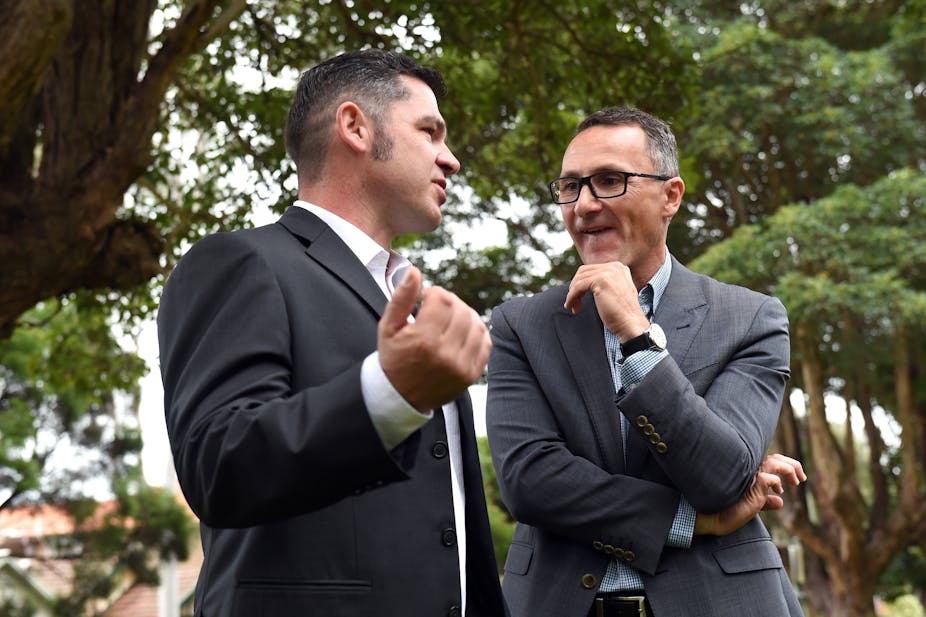Before the 2007 election, Kevin Rudd vowed to “mess” with John Howard’s mind. He did and it worked.
Now, the government is trying to repeat the trick with Bill Shorten, and the Greens are their handmaidens. Talk of preference deals is the Coalition’s chief weapon, but so is Labor division over border protection, propaganda about a Labor-Green coalition, and Green opportunism on penalty rates.
At immediate risk for Labor are a number of inner-city seats, especially in Melbourne. The danger for the Greens are unintended consequences flowing from their flirtation with preference deals with the Coalition. It might just work too well, not merely damaging Labor, but also reducing the Greens’ overall influence and impact in the next parliament.
The Greens hold the seat of Melbourne courtesy of Liberal preferences in 2010 and incumbency at the last election. The Labor seats of Batman and Wills, where Labor’s vote fell below 50% at the 2013 election, are at serious risk of following the same pattern on July 2 if the Liberals direct preferences to the Greens.
According to ABC psephologist Antony Green, the Greens could not win either seat without Liberal preferences – unless their primary vote overtakes Labor’s.
That is possible, but unlikely. It is even less likely in another seat being targeted by the Greens – the electorate of Grayndler in Sydney, held by Labor’s Anthony Albanese. His primary vote was in the high 40s in 2013 and the Greens were outpolled by the Liberals.
Melbourne Ports is another interesting but different case. Labor’s Michael Danby was outpolled by the Liberals at the last election, but retained the seat on the back of Green preferences. According to Green, a 6% switch in primary votes between Labor and the Greens would see the seat fall to the Greens – or the Liberals, depending on who preferences whom.
Just to be clear, no Liberal seats are at risk. The Coalition gains by putting Labor under pressure in seats it has held for decades, in some cases since federation. Liberal preferences would hand Batman and Wills to the Greens.
According to Liberal strategists, the threat to Labor in those two seats is already forcing them to commit hundreds of thousands of dollars to defend a pair of electorates it could once take for granted. That means less money to spend on seats Labor needs to win if it is to return to government.
This is already an uphill task, given that Labor needs to gain 20 seats nationwide to topple a first-term government – a feat not achieved federally since 1931. Given the current state of the polls, the best Labor can expect is another hung parliament. But that prospect creates tactical problems for Shorten, not the Coalition.
First, it would mean that whoever emerged as prime minister would have to assure the governor-general that he had the confidence of the House of Representatives. Shorten has recoiled from the Greens’ suggestions of another alliance, like that negotiated by Julia Gillard, like Dracula from a stake.
However, talk of any kind of agreement to guarantee passage of money bills is sufficient for the Coalition to raise the spectre of the last hung parliament with the memory of Gillard and Bob Brown joined at the hip, surrounded by rancour and dysfunction.
Second, it makes Labor look more left-wing than Shorten would like, as does mere talk of Labor being dependent on Green preferences to hold Batman, Wills and Grayndler among others.
The votes Shorten needs to attract are in the centre, winning primary votes at the expense of the Coalition. He cannot win more votes on the left. The less centrist his appeal, the fewer votes he will win from the government.
Shorten is caught in a vice between Liberal claims that he is beholden to the Greens and Green suggestions that Labor has lost its moral compass. On that score, the Coalition has now produced dirt sheets on at least seven Labor candidates, quoting past statements opposing turnbacks and offshore processing of asylum seekers. Undoubtedly, we have not heard the end of this.
The government argues this shows what Labor really thinks; that a Shorten prime ministership would again see boatloads of asylum seekers making it to Australian waters. For Greens voters, it is a daily reminder of Labor’s lack of compassion.
It is a similar story with the Greens’ opportunism on weekend penalty rates. Shorten is pointing out, quite reasonably, that legislating for double time on Sundays – as Greens leader Richard Di Natale is proposing – could quite readily be undone by a Coalition government.
On the other hand Shorten is committing a Labor government to a submission to Fair Work Australia in support of maintaining penalty rates. That ought to have considerable influence over whatever decision the independent commission makes.
The Greens, however, depict themselves as the only friends the workers have left, and portray Shorten as betraying his union roots. Another win for the Coalition.
For all that, it is just possible that the Greens could play this game too successfully.
Changes to the Senate voting arrangements mean they will lose one or possibly two of their ten seats. On the other hand, rightist independent Nick Xenophon might just win four seats in South Australia. Family First’s Bob Day might retain his seat, as might the Liberal Democrats’ David Leyonhjelm. That would give the crossbench a more conservative tinge, reducing the power of the Greens.
In the lower house, competition with Labor might produce more Green MPs. But downward pressure on Labor’s vote nationally might ensure the Coalition’s majority.
In short, it could mean greater numbers for the Greens in the lower house, but less influence and fewer senators. This would in turn mean the continuation of Tony Abbott’s climate-change policy and pressure from the business community for further industrial relations changes, not just the abolition of penalty rates.
Careful what you wish for.

